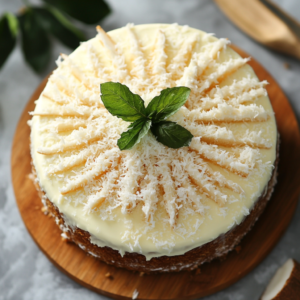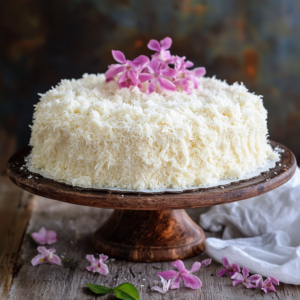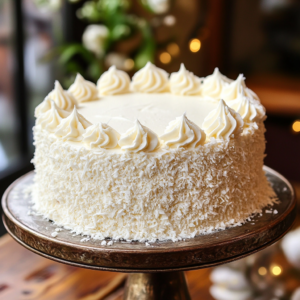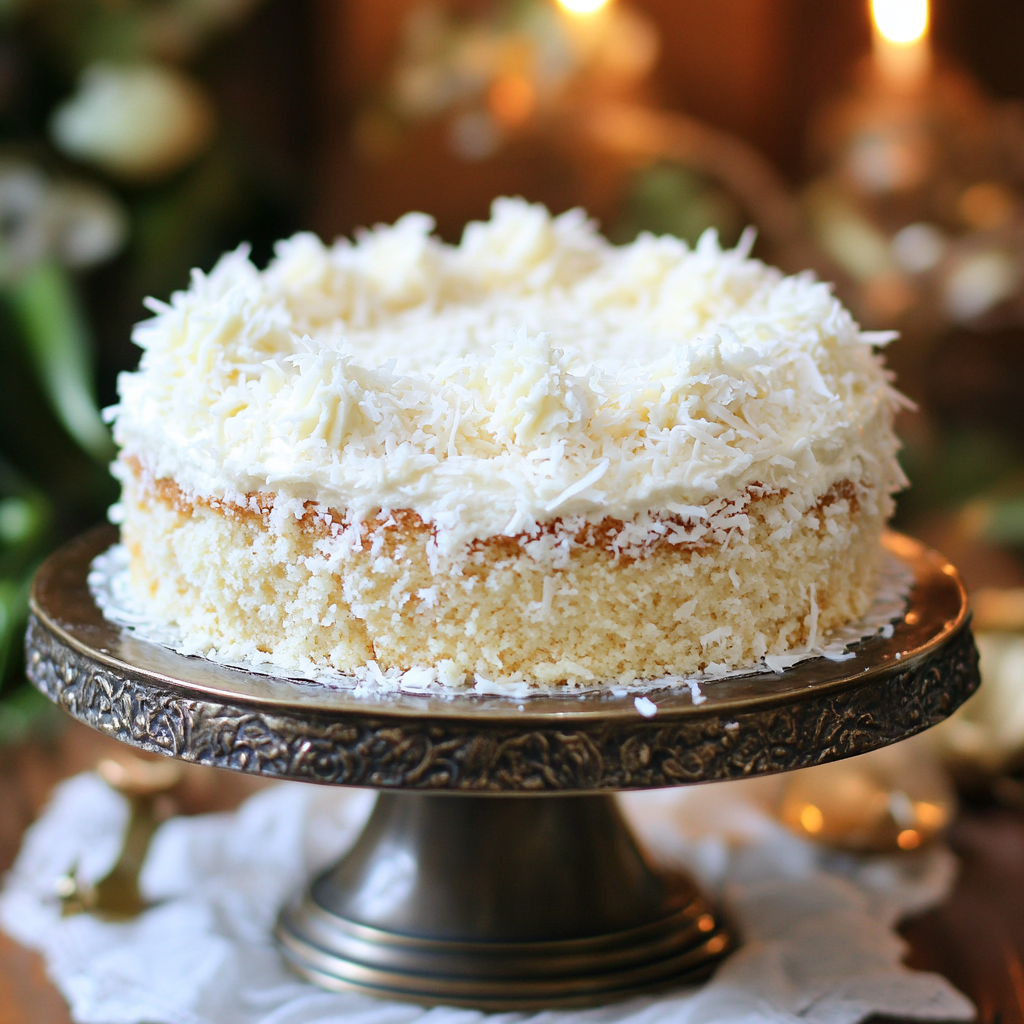Introduction 
Coconut cake is a delightful dessert that combines the tropical flavors of coconut with a soft and fluffy texture. Whether you’re celebrating a special occasion or simply treating yourself, this cake will surely impress your friends and family. The combination of rich flavors and lightness makes it a versatile choice for birthdays, weddings, or even a casual afternoon tea. The sweet aroma of freshly baked coconut fills the kitchen as you prepare this delicious treat. In just a few simple steps, you can create an unforgettable dessert that showcases the delightful taste of coconuts.
This coconut cake recipe is not only easy to follow but also calls for ingredients that are likely already in your pantry. With its fluffy layers and creamy frosting, you’ll create a masterpiece worthy of any celebration. As you dive into this recipe, you will discover how each ingredient contributes to the overall flavor and texture of the cake. So gather your supplies and get ready to bake the ultimate coconut cake that will leave everyone asking for seconds!
Ingredients
Flour
For this coconut cake recipe, you’ll need 2 cups of all-purpose flour. Flour serves as the foundation of the cake, providing structure and stability. Be sure to measure it accurately; too much flour can lead to a dense cake while too little might cause it to collapse. Sifting the flour before measuring can help aerate it and ensure an even texture throughout.
Sugar
You will need 1 ½ cups of granulated sugar for sweetness. Sugar not only adds flavor but also helps retain moisture in the cake, making it tender and soft. It caramelizes during baking, giving your coconut cake a beautiful golden brown exterior. Feel free to adjust the sweetness based on your preference; however, keep in mind that reducing sugar may affect the moisture content.
Baking Powder
Add 1 tablespoon of baking powder to help your cake rise perfectly. Baking powder is a leavening agent that creates carbon dioxide bubbles when mixed with liquid ingredients and heat in the oven. This reaction causes your batter to expand and results in a light and airy structure after baking.
Eggs
You need 4 large eggs for richness and moisture in this recipe. Eggs contribute not only flavor but also act as binders that hold all ingredients together while providing structure as they cook. They help create that beautiful crumb texture we all adore in cakes.
Coconut Milk
Incorporate 1 cup of full-fat coconut milk into your batter for added creaminess and flavor depth. Coconut milk enhances both taste and moisture content while adding richness without being overly heavy. It complements the other ingredients perfectly, creating that signature tropical essence associated with coconut cakes.
Shredded Coconut
Use 1 cup of unsweetened shredded coconut for texture and flavor throughout the layers of your cake. Shredded coconut provides delightful chewiness while intensifying the overall coconut flavor profile; it’s essential for achieving true authenticity in this recipe.
How to Prepare Coconut Cake
Step 1: Preheat Your Oven
Preheat your oven to 350°F (175°C). Properly preheating ensures even cooking throughout all layers of your coconut cake. An adequately heated oven allows the batter to rise correctly while developing a golden crust on top without over-baking the inside.
Step 2: Prepare Your Baking Pans
Grease two round 9-inch baking pans using butter or non-stick spray before lining them with parchment paper at the bottom—this prevents sticking during cooling later on! Take time here; well-prepared pans are crucial for effortless removal post-baking.
Step 3: Mix Dry Ingredients
In a large mixing bowl, combine flour and baking powder together using either whisking or sifting methods until evenly blended—this step helps distribute leavening agents effectively throughout dry components before incorporation into liquids later on!
Step 4: Cream Butter & Sugar
In another large bowl (preferably using an electric mixer), beat together softened butter (1 cup) along with granulated sugar until lightened in color & fluffy (approximately five minutes)—this process incorporates air into mixture ensuring proper rise upon baking!
Step 5: Incorporate Eggs
Next comes eggs! Add one egg at a time ensuring each fully incorporates before proceeding onto next addition—this technique guarantees even distribution leading towards better-textured end result post-bake!
Step 6: Alternate Wet/Dry Ingredients
Begin alternating between adding dry mixture previously prepared followed by wet components like room temperature whole milk & vanilla extract along with shredded coconuts—mix gently until fully combined avoiding overmixing which could lead towards dense baked goods instead fluffy goodness desired from our lovely creation!
Serving and Storing Tips
Serving Suggestions
When serving your delicious coconut cake, consider garnishing it with additional shredded coconut flakes or slices of fresh fruit like pineapple or mangoes! These toppings enhance visual appeal while complementing existing flavors beautifully! For larger gatherings slice into generous portions allowing guests plenty opportunity indulge without fearing leftovers remaining behind after event concludes!
Storage Recommendations
To store leftover slices properly wrap them tightly in plastic wrap or place them inside an airtight container—this prevents drying out due exposure air around them! Ideally refrigerate up-to four days however if longer storage required freeze individual slices instead keeping maximum freshness intact even month later enjoyed straight from freezer thawed overnight fridge beforehand indulging again anytime craving strikes!
With these detailed instructions alongside helpful tips about serving options available anyone can master creation delectable homemade coconuts cakes effortlessly pleasing taste buds delightfully captivating audiences everywhere they go! Enjoy baking journey ahead!
Mistakes to avoid
One common mistake when baking a Coconut Cake is not measuring your ingredients accurately. Baking is a science, and even small discrepancies can affect the cake’s texture and flavor. Always use dry measuring cups for solids and liquid measuring cups for liquids. Invest in a kitchen scale for precision, especially when using flour and sugar. This will help you achieve consistent results every time.
Another mistake is overmixing the batter. While it may be tempting to ensure everything is combined well, overmixing can lead to a dense cake. Mix just until the ingredients are incorporated. It’s perfectly fine to have a few lumps in the batter—this will result in a lighter, fluffier Coconut Cake.
Not preparing your pan correctly is another pitfall many bakers face. Always grease and flour your baking pans or line them with parchment paper before pouring in the batter. This prevents sticking and ensures easy removal once your cake is baked. Additionally, check the size of your pans; using the wrong size can lead to uneven baking.
Finally, neglecting to allow your Coconut Cake to cool properly can ruin all your hard work. After removing it from the oven, let it rest in the pan for about 10 minutes before transferring it to a wire rack. This cooling process helps maintain the cake’s moisture and prevents it from crumbling.
Tips and tricks
To achieve the best Coconut Cake possible, consider using fresh coconut instead of pre-packaged shredded coconut. Fresh coconut provides a richer flavor and better texture compared to its dried counterpart. If fresh coconut isn’t available, opt for unsweetened shredded coconut for a more authentic taste.
Incorporating coconut milk into your recipe can elevate the flavor profile significantly. Substitute part of the regular milk with coconut milk to enhance that tropical taste that complements the cake beautifully. Aim for a balance so that it does not make the batter too wet.
When frosting your Coconut Cake, be mindful of using cream cheese or buttercream frosting that balances sweetness with richness. A light and airy frosting will complement the moistness of the cake without overwhelming it. Consider adding some toasted coconut flakes on top for an additional layer of texture and visual appeal.
Finally, let your Coconut Cake sit after assembling it with frosting before serving. Allowing it to rest helps flavors meld together, making each bite even more delightful. Wrap leftovers tightly to keep them fresh—Coconut Cakes often taste even better after a day or two in the fridge as flavors continue to develop.
Suggestions for Coconut Cake
For an extra burst of flavor, try adding lime zest or juice into your Coconut Cake batter. The citrus notes pair wonderfully with coconut and give an unexpected twist that elevates this classic dessert.
If you’re looking to make this treat gluten-free, substitute regular flour with almond flour or a gluten-free flour blend designed for baking cakes. Just be aware that adjustments in liquid ratios may be necessary if you use alternative flours.
Consider layering flavors by incorporating other ingredients such as pineapple or passion fruit into your cake layers or frosting. These fruits complement coconut beautifully and create a tropical delight that’s perfect for any gathering.
Additionally, don’t shy away from experimenting with different types of frostings beyond traditional buttercream or cream cheese options. A light whipped cream frosting infused with coconut extract creates a smooth finish that enhances rather than masks the flavor of your Coconut Cake.
FAQs
What type of coconut should I use for my Coconut Cake?
When choosing coconut for your Coconut Cake, fresh coconut is ideal due to its rich flavor and texture. However, if fresh isn’t accessible, unsweetened shredded coconut is an excellent alternative as it retains much of that natural essence without unnecessary additives.
Can I make my Coconut Cake ahead of time?
Yes! You can bake your Coconut Cake up to two days ahead of serving. Once cooled completely, wrap each layer tightly in plastic wrap and store them at room temperature or refrigerate them if you prefer longer freshness.
How do I store leftover Coconut Cake?
To store leftover Coconut Cake properly, cover it loosely with plastic wrap or aluminum foil at room temperature if consumed within two days. For longer storage, refrigerate it wrapped tightly; this helps maintain moisture while preventing it from drying out.
Can I freeze Coconut Cake?
Freezing is possible! To freeze your Coconut Cake effectively, slice individual portions or keep it whole wrapped tightly in plastic wrap followed by aluminum foil or an airtight container; this protects against freezer burn while preserving flavor.
Conclusion
Baking a delicious Coconut Cake requires attention to detail and some knowledge of common mistakes and tips that can enhance your results significantly. By avoiding pitfalls like inaccurate measurements or overmixing batter, you set yourself up for success each time you bake this tropical delight. Incorporating fresh ingredients like lime zest or opting for unique frostings allows you to personalize this classic dessert further.
Remember also that proper storage techniques play an essential role in maintaining freshness after baking—whether it’s keeping slices covered at room temperature or freezing portions for later enjoyment, those choices matter too! With these guidelines in mind, you’re ready to create a stunning Coconut Cake that’s sure to impress everyone who tastes it! Happy baking!



